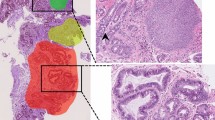Abstract
Esophageal cancer is increasing in frequency in the United States faster than any other cancer. Barrett's esophagus, an otherwise benign complication of esophageal reflux, affects approximately three million Americans and precedes almost all cases of esophageal cancer. If detected as high-grade dysplasia (HGD), most esophageal cancers can be prevented. Standard-of-care screening for dysplasia uses visual endoscopy and a prescribed pattern of biopsy. This procedure, in which a tiny fraction of the affected tissue is selected for pathological examination, has a low probability of detection because dysplasia is highly focal and visually indistinguishable. We developed a system called endoscopic polarized scanning spectroscopy (EPSS), which performs rapid optical scanning and multispectral imaging of the entire esophageal surface and provides diagnoses in near real time. By detecting and mapping suspicious sites, guided biopsy of invisible, precancerous dysplasia becomes practicable. Here we report the development of EPSS and its application in several clinical cases, one of which merits special consideration.
This is a preview of subscription content, access via your institution
Access options
Subscribe to this journal
Receive 12 print issues and online access
$209.00 per year
only $17.42 per issue
Buy this article
- Purchase on Springer Link
- Instant access to full article PDF
Prices may be subject to local taxes which are calculated during checkout





Similar content being viewed by others
References
Backman, V. et al. Detection of preinvasive cancer cells. Early-warning changes in precancerous epithelial cells can be spotted in situ. Nature 406, 35–36 (2000).
Gurjar, R.S. et al. Imaging human epithelial properties with polarized light scattering spectroscopy. Nat. Med. 7, 1245–1248 (2001).
Perelman, L.T. et al. Observation of periodic fine structure in reflectance from biological tissue: a new technique for measuring nuclear size distribution. Phys. Rev. Lett. 80, 627–630 (1998).
Wallace, M.B. et al. Endoscopic detection of dysplasia in patients with Barrett's Esophagus using light scattering spectroscopy: a prospective study. Gastroenterology 119, 677–682 (2000).
Backman, V. et al. Polarized light scattering spectroscopy for quantitative measurement of epithelial cellular structures in situ. IEEE J. Sel. Top. Quant. Elect. 5, 1019–1027 (1999).
Kara, M.A. et al. Detection and classification of the mucosal and vascular patterns (mucosal morphology) in Barrett's esophagus by using narrow band imaging. Gastrointest. Endosc. 64, 155–166 (2006).
Kara, M.A. et al. Endoscopic video autofluorescence imaging may improve the detection of early neoplasia in patients with Barrett's esophagus. Gastrointest. Endosc. 61, 679–685 (2005).
Curvers, W.L. et al. Endoscopic tri-modal imaging for detection of early neoplasia in Barrett's oesophagus: a multi-centre feasibility study using high-resolution endoscopy, autofluorescence imaging and narrow band imaging incorporated in one endoscopy system. Gut 57, 167–172 (2008).
Pohl, H. et al. Miniprobe confocal laser microscopy for the detection of invisible neoplasia in patients with Barrett's oesophagus. Gut 57, 1648–1653 (2008).
Fang, H. et al. Noninvasive sizing of subcellular organelles with light scattering spectroscopy. IEEE J. Sel. Top. Quant. Elect. 9, 267–276 (2003).
Riddell, R.H. et al. Dysplasia in inflammatory bowel disease: standardized classification with provisional clinical applications. Hum. Pathol. 14, 931–968 (1983).
Georgakoudi, I. et al. Fluorescence, reflectance, and light-scattering spectroscopy for evaluating dysplasia in patients with Barrett's esophagus. Gastroenterology 120, 1620–1629 (2001).
Levine, D.S. et al. An endoscopic biopsy protocol can differentiate high-grade dysplasia from early adenocarcinoma in Barrett's esophagus. Gastroenterology 105, 40–50 (1993).
Cameron, A.J. & Carpenter, H.A. Barrett's esophagus, high-grade dysplasia, and early adenocarcinoma. A pathological study. Am. J. Gastroenterol. 92, 586–591 (1997).
Cameron, A.J. Management of Barrett's esophagus. Mayo Clin. Proc. 73, 457–461 (1998).
Macdonald, C.E., Wicks, A.C. & Playford, R.J. Final results from 10 year cohort of patients undergoing surveillance for Barrett's oesophagus: observational study. Br. Med. J. 321, 1252–1255 (2000).
Acknowledgements
This study was supported by US National Institutes of Health grants EB003472 and RR017361, by US National Science Foundation grant BES0116833 and, in part, by the US Department of Veterans Affairs Office of Research and Development. We thank R. Chinnock and F. Bargoot of Optimum Technologies, Inc., for help with the fiber optic probe development. We thank Olympus for the loan of the endoscope used in the animal experiments.
Author information
Authors and Affiliations
Contributions
L.Q., E.V., M.D.M., E.B.H., I.I. and L.T.P. developed and evaluated the method; S.I., L.Q. and E.V. contributed codes for instrument control; D.K.P., R.C., J.D.G., J.L., N.O., L.G., L.Q. and A.S. performed clinical procedures; L.Q., D.K.P., R.C., E.B.H., I.I. and L.T.P. contributed to the writing of the manuscript; E.B.H., I.I., D.K.P., R.C. and L.T.P. designed and planned the project.
Corresponding author
Ethics declarations
Competing interests
The authors declare no competing financial interests.
Supplementary information
Supplementary Text and Figures
Supplementary Figures 1–3 and Supplementary Methods (PDF 391 kb)
Supplementary Video 1
This video shows in real time the EPSS probe scanning a 2-cm section of esophagus during an endoscopy screening procedure. The regions of Barrett's esophagus, distributed in a diffuse pattern, appear darker in the video, which was acquired by the NBI mode of the endoscope. (MOV 9326 kb)
Rights and permissions
About this article
Cite this article
Qiu, L., Pleskow, D., Chuttani, R. et al. Multispectral scanning during endoscopy guides biopsy of dysplasia in Barrett's esophagus. Nat Med 16, 603–606 (2010). https://doi.org/10.1038/nm.2138
Received:
Accepted:
Published:
Issue Date:
DOI: https://doi.org/10.1038/nm.2138
This article is cited by
-
In vivo detection of bile duct pre-cancer with endoscopic light scattering spectroscopy
Nature Communications (2023)
-
Cancer characterization using light backscattering spectroscopy and quantitative ultrasound: an ex vivo study on sarcoma subtypes
Scientific Reports (2023)
-
Surgical polarimetric endoscopy for the detection of laryngeal cancer
Nature Biomedical Engineering (2023)
-
Esophageal OCT Imaging Using a Paddle Probe Externally Attached to Endoscope
Digestive Diseases and Sciences (2022)
-
Novel endoscopic optical diagnostic technologies in medical trial research: recent advancements and future prospects
BioMedical Engineering OnLine (2021)



